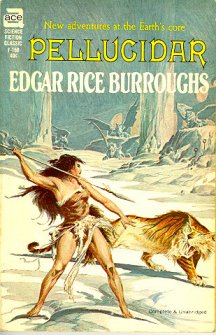 All
right, if you've read my other Pellucidar articles (and if you've read
this far, I can only assume that you're completely hopeless) then you know
I've been working on the assumption that Pellucidar is exactly what it
seems: A hollow world inside our own.
All
right, if you've read my other Pellucidar articles (and if you've read
this far, I can only assume that you're completely hopeless) then you know
I've been working on the assumption that Pellucidar is exactly what it
seems: A hollow world inside our own.
In part, this notion is supported by the existence of
a second hollow world, Va-Nah, inside the Moon, and by the lunar Hoos or
holes between inner and outer surfaces.
Applying this notion of Hoos to our own geologically more
lively world, and we have an explanation for the proliferation of ‘lost
worlds’ - Skull Island, Caprona, Professor Challenger's and Jan of the
Jungle's two south American lands, Tam and Morgo's subterranean world in
the Himalayas, Jongor's lost world in Australia, Burroughs Pal-Ul-Don in
Africa, Carter's Zanthodon. They're all ‘islands of Pellucidar,
brought to or near the surface by temporary holdes or hoos.
It's elegant, symmetrical, explains a lot that otherwise
poses problems....
And it requires some seriously wacky physics in the Burroughs
Universe.
Putting it very simply, in the Burroughs universe gravity
and physics just can't work in the same way that they do in our universe.
They have to be tweaked just a little bit.
That's not a big stretch. Because the cumulative
evidence is that the laws of physics really are just a bit different from
the laws here. Otherwise Tarzan couldn't possibly get away
with some of the stuff that he manages. Otherwise, Mars and
Venus are dead worlds, just like in our Universe. Otherwise Barsoomian
flyers just are not going to work.
But what if I'm wrong.
What if something completely different is going on with
Pellucidar?
Reading Burroughs Pellucidar novels, there is a clue that
the rules may be different than we think. The key is time.
Now here's the interesting thing. In Burroughs Pellucidar,
time seems to run differently. Burroughs repeatedly writes
that time seems to stand still in Pellucidar, that it seems to be subjective.
Thus, a person might step away from his village and wind
up having all sorts of crazy adventures. But when, after all
those adventures, he finally returns to his village, he discovers that
no one has missed him because he hasn't been gone all that long.
The subjective time experienced by the village is very different from the
subjective time experienced by the adventurer.
It's an important enough feature of life in Pellucidar
that Burroughs refers to it over and over, in practically every book.
He attributes it to the fact the sun never sets, thus, the cycle of days
and nights which allows for circadian rhythms simply doesn't happen.
I think that there's an element of real life to it.
In our subjective existence, our perception of time seems to speed up or
slow down in different circumstances. Burroughs simply magnifies
this phenomenon.
Actually though, in real life, there have been experiences
conducted with people in caves away from every source of light and natural
circadian rhythm. And the sense of time passing seems generally
to be both steady and synchronous with other people.
So, obviously, Burroughs just got it wrong with Pellucidar.
Or perhaps its just a feature of people in the Burroughs universe that
their subjectivity is heightened.
Or maybe not.

 In Savage Pellucidar, we get some pretty clear statements
that something is going on very very strangely with the passage of time.
Something that has to be more than just different rates of subjective perception.
David Innes writes at the outset of the novel:
In Savage Pellucidar, we get some pretty clear statements
that something is going on very very strangely with the passage of time.
Something that has to be more than just different rates of subjective perception.
David Innes writes at the outset of the novel:
Neither Perry nor I show
any physical evidence of the passage of time. I was twenty when the iron
mole broke through the crust of Pellucidar, and I don't look nor feel a
great deal older now.
When I reminded Perry that he was
one hundred and one years old, he nearly threw a fit. He said it was perfectly
ridiculous and that Jason Gridley must have been hoaxing me; then he brightened
up and called my attention to the fact that I was fifty-six. Fifty-six!
Well, perhaps I should have been had I remained in Connecticut; but I'm
still in my twenties down here.
In Savage Pellucidar we meet a very, very strange
person. A man so old and insane that he doesn't quite remember
his own name, but he's pretty sure its not Dolly Dorcas. He's
called simply Ah Gillak.
Like Innes and Perry, he's a man from the outside world.
But he's not just any man. He was a seaman from a yankee whaling
ship called the Dolly Dorcas which managed to accidentally sail or be driven
north, through a temporarily open passage through the Polar ice fields
into Pellucidar.
There's no reason to assume he's lying, and everyone acknowledges
that he's very old. According to Ah Gilak, his ship was lost
in 1845 when he was over forty years old. But if we take him at his
word, his references to the outside world suggest that chronologically,
he must be somewhere older than 150 years.
And despite his age, he's in pretty good shape.
In our world, people once they get past eighty seem to get pretty frail.
The few who make it past one hundred tend to be not much good for more
than standing up and sitting down.
He's toothless and insane, but given the life he's had
to live that's par for the course. He's not a drooling gomer,
instead, he's spry and nimble. As fit and active as a man in his
fifties or early sixties.
Well, look, there's physics and then there's physics.
Either in the Burroughs Universe, people are considerably more long lived
and resilient than in our universe (true actually, both Barsoomians and
Amtorians have incredibly long natural or artificial lifespans, Tarzan
seems gifted with near immortality) or time really is operating differently.
This is what I want to explore. Suppose that
in Pellucidar, time really is moving at different rates in different places,
and moving substantially more slowly than in our world, overall.
Most of the time there wouldn't be much initial difference in the course
of an hour or a day, but over months or years differences mount rapidly.
If this is true, then Pellucidar may be a very different
place than we have imagined. Instead of mucking about with
Newtonian mechanical physics, Pellucidar may be a place where fundamental
Einsteinian or Heisenberg physics works differently. In short,
Pellucidar may be a place where time and space have fundamentally different
properties.
In short, Pellucidar may not be on the inside of our or
Burroughs Earth at all. Burroughs Earth may actually be solid
all the way through and more or less like our own.
Pellucidar may not actually be in our spacetime continuum
at all.
If so, then what is it and how does it work?
And what conclusions can we draw?
If Pellucidar isn't actually in our spacetime continuum,
its pretty solidly anchored to it. The Polar Opening is a stable
one, and seems to link stable points on both Pellucidar and our Earth.
Tarzan goes through it and comes back the same way. Before
Tarzan, Ah Gilak came through it. And before him, the Corsairs came
through.
Ralph Milne Farley’s Pellucidarean Radio Flyer and Radio
Gun Runner stories also suggest that the polar opening is stable.
Meanwhile, it appears that David Innes digging machine seems to suggest
that points of Pellucidar had reasonably stable relationships to points
on Earth.
However, Pellucidar seems to have multiple time streams
moving in it. Pellucidar, as far as time goes, seems to be
a multi-lane highway with different speeds on each lane. Our
world, our reality is a pokey one lane time road. There's
no indication that time goes backwards in Pellucidar, but by moving from
one lane to another, you can play with your speed of progress.
It appears that humans in Pellucidar may tend to be drawn
to or settle in the slower lanes. Thus most occasions, time
movies faster when people are off having adventures because they're climbing
up into the higher speed lanes.
On the other hand, hanging around in the slow lanes probably
slows development and makes you more vulnerable to visitors, human and
otherwise, from faster lanes.
But here's an interesting notion. Perhaps
Pellucidar isn't even an inner world.
In this sense, Pellucidar's moon has always been a bit
of a problem. An internal geosynchronous satellite, always
rotating in a stable stationary orbit, always balanced between inner sun
and inner crust, seems more than a bit unstable. Hell, in our
Universe, Phobos and Deimos are not stable satellites.... In
tens of millions of years, Phobos is going to make a very big hole on Mars.
If we accept that time is doing strange things, and moving
at different rates in different geographical locations of Pellucidar, then
what about light? In our universe, light is a fixed constant,
part of the set of equations that govern space and time.
In Pellucidar, time is a flexible part of the equation
which varies from space to space. Which suggests that light
passing through different time zones may move differently, at different
rates. It may even bend.
So light interacting with a world where time is in flux,
may create distortions. The geography of Pellucidar we observe
from any one point may not represent physical reality, but be subject to
distortions like a mirage. Perhaps the biggest distortion is
that instead of a flat horizon, Pellucidar's horizon seems to curve upwards,
as if we were in a bowl, until it becomes indistinct.
What this implies is that Pellucidar is a regular ‘outside’
world like our own, and its ‘bowl shaped’ landscape may simply be an illusion
of its particular and very peculiar physics.
But this brings us back to the question of what exactly
is Pellucidar and how does it relate to our world. Is Pellucidar
a parallel world, or a pocket world.
A parallel world is basically a universe adjacent to ours,
where there is a difference. Arguably, any event which can
go two different ways creates a parallel world - with two possible event
decisions, two worlds are created representing each decision.
This implies infinite numbers of parallel worlds, endlessly splitting.
The parallel worlds closest to us, and the ones we're
most likely able to visit, will be the ones most similar to ours.
Perhaps we're constantly drifting in and out of these parallel worlds,
without ever noticing, because in most cases, the world we're visiting
is simply the world where Rajneev Jaywardene of New Delhi went to work
with a plaid tie instead of a blue one.
Pellucidar is a pretty seriously deformed parallel world
if fundamental properties of time are diverging. So the likelihood
is that it is not a parallel world, or not one in the normal course.
Perhaps Pellucidar is so far down the continuum that its wacky physics
literally ‘wormholes’ into Burroughs normal universe.
The thing with a parallel world is that it is not confined
to the world but literally, comes with an entire universe.
The properties of that universe, its history, its life and age, are different.
Which poses problems. In a universe where time flows at different
rates, would we get stars? Would stars have the same life cycle or
function in the same way? Would Earth and the Solar system have formed
at all? Or formed in the same way, or on the same timing?
Unlikely. The most likely result of a universe where the laws
of time are as variable as we see is that Pellucidar probably wouldn't
have come into existence at all.
So what
about pocket worlds?
A pocket world is a sort of ‘baby universe’?
A self contained realm which is not a parallel to our Universe, but which
presumably contains a different volume of mass and matter, and which might
have different laws.
Science fiction writers have played with the notion of
pocket universes for different purposes. You could for instance,
use it for more closet space. Philip Jose Farmer used pocket
universes for his ‘World of Tiers’ series.
The advantage of a pocket universe is that it's obviously
potentially much smaller than our regular universe. Perhaps
the size of a Solar System, or a world, or a country, or even a really
really huge closet. And you can make the rules in a pocket
universe as different as you'd like.
Does this mean a pocket world has to be artificial?
Not necessarily. I think modern physics allows for the possibility
of natural formations. Indeed, a black hole, in some theories
represents a pocket universe. It's intense internal conditions
literally wall it off from the physics of our universe.
So it may be that in our Universe, or more accurately,
in Burroughs Universe some interaction of planet scale gravity and electromagnetism
may create a local pocket world, or doppleganger world. It may be
significant that Pellucidar's permanent interfaces to our world are at
the poles. The relationship between Pellucidar and Burroughs
Earth may be stabilized by electro-magnetism.
It may be that in Burroughs Universe, the process which
creates a planet, and the resulting well of gravity, may also create a
sort of conjoined twin or siamese twin, tied to the original world, but
off in its own pocket continuum. This would explain Va-Nah.
Pellucidarean pocket worlds, given the fact that we have
two examples already, are probably common in the Burroughs Universe.
Disappointingly though, this probably means that Barsoom's, Amtor's, Mercury's
and Callisto's ‘Pellucidarean’ realms do not resemble my projections at
all. Oh well, back to the drawing board.
On the other hand, this alternate ‘pocket universe’ theory
still explains the proliferation of lost worlds that Explorers were discovering.
These lost worlds are all aspect or outliers of Pellucidar. The only
difference is that instead of being extrusions of the interior world onto
the surface, they're points where the pocket universe has interfaced with
our universe, creating perhaps a temporary gateway, a ‘micro-universe’
or left an ‘island’ in our world. Professor Challenger's
lost world, or Caprona, are little bits of Pellucidar that have extruded
into our world and become sort of sealed off. In turn, bits
of our world keep extruding into Pellucidar, which is how it accumulates
all those terrestrial species.
Any evidence for this? Well, we can assume
that extrusions into the normal world may have strange properties.
Compasses probably don't work well, navigation by stars or sun, becomes
unreliable due to distortions in the electromagnetic spectrum.
In short, you'd see a lot of the weird phenomena that make places like
Skull Island and Caprona so hard to find.
The extrusions or interfaces may not be completely in
our world, so they may only be accessible by certain routes or from certain
directions. There may only be a few ways into Pal-Ul-Don or
Professor Challenger's Lost World. You might not be able to
fly in by helicopter, or even see it by satellite photograph.
It would only be perceptible to our regular world by certain ‘windows.’
Again, this explains why so many of them seem so hard to find, or to escape.
Many Lost Worlds, particularly those in later works, including television
and movies, don't seem to quite be in our world. This includes
the children's show Land of the Lost, or Acclaim Comics lost world out
of time.
One clue that this might be going on is that in some cases
there are signs of time proceeding in these lost worlds differently.
The best example is Zanthodon by Lin Carter, where the perceptions of time's
being subjective are very similar to those in Pellucidar. In
Eric Carstairs of Zanthodon, we encounter a group of displaced German soldiers
from Rommel's Afrika campaign for whom far less time seems to have passed
than has passed in the outside world.
There are recurring hints in some stories of a ‘Rip Van
Winkle’ effect for staying in these places too long. Most visits
to places like Skull Island or Professor Challengers Lost World tend to
be short, so we wouldn't expect time distortions to be pronounced.
But every now and then we find a castaway who has spent a lot of time there,
and quite often, there's something a little bit odd.
Of course there are problems. For instance,
why are the Lost Worlds invariably surrounded by physical distortions....
Mountains, plateaus, swamps, etc., and why are they often accessible by
apparently physical connections... twisting caverns. This makes
it seem that the Lost Worlds are geological in nature, rather than interfaces
with another continuum. And for that matter, what exactly is Pellucidar's
sun? Our sun shining down into Pellucidar's continuum?
It's own star? Something else? Still, if we worked hard
enough, these questions could probably be answered.
The bottom line is that we can probably explain Pellucidar
at least as well as a Pocket Universe as we can explain it as an Inner
World. In each case, Pellucidar can be used as the source and
explanation for the multitude of other lost worlds that we encounter.
I suppose its a matter of preference which way we choose
to go. The big question is why bother at all?
I suppose I should explain myself by saying something
more elaborate than that it's fun. Pellucidar in our reality
is flatly impossible. It's just not going to happen.
It's pretty much proven that an inner world is not an option, our planet
is solid all the way through, except where its molten. Nor
does modern physics really allow for a pocket universe anything like Pellucidar.
So in our world, it's not an option.
Except that in Burroughs world, Pellucidar is a reality.
If we accept Tarzan's adventures as a ‘reality’ then Pellucidar has to
be ‘real’ because Tarzan goes there. The Gridley wave is used
to communicate with Barsoom, which tells us that John Carter is also in
Tarzan's reality. In the Moon Maid, communication is
taking place with Barsoom, which puts that series in Tarzan's reality.
Carson goes to Venus heading for Mars, which puts him in Barsoom's and
therefore Tarzan's reality. Even in the Land That Time Forgot
there's a throwaway reference to there being life on Mars.
So, Pellucidar is a part of Burroughs world.
Which means that we're entitled to ask how that could possibly work.
Any half competent scientist will tell you it can't, obviously.
But then, there's a story about Albert Einstein. Some kid wrote
in to Einstein complaining about Superman flying faster than the speed
of light because this violated the theory of relativity. Einstein
wrote back that relativity was a theory, but Superman's flying faster than
the speed of light was a fact.
Well, Pellucidar is a fact, at least as far as Tarzan
is concerned. Now, Philip Jose Farmer, faced with the problem
of Pellucidar, simply gave up and pronounced it all imaginary.
His idea was that Tarzan existed in our real world, or at least a much
closer version, and was willing to throw out anything he thought a little
too unrealistic... Which, as far as I was concerned, was just about
all the fun stuff. Sadly, the Wold Newton folk have followed
this path, picking and choosing what they liked, and making up new facts
as substitutes, from which they've built worlds as baroque as any fantasy.
Well, Burroughs for better or worse made it part of his
world, so we shouldn't just toss it. And if we don't toss it, we
have to try and make some sort of sense of it.
In the end, we all take our choices. I hope
you've been enjoying these things. Perhaps it'll inspire you
to do some writing or speculating of your own.




![]()
![]()
![]()
![]()

![]()